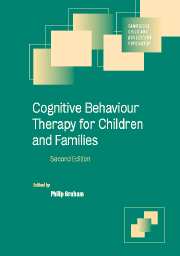Book contents
- Frontmatter
- Contents
- List of contributors
- 1 Introduction
- Part I Developmental cognitive theory and clinical practice
- Part II Engagement and assessment
- Part III Client groups
- Part IV Applications in psychosocial adversity
- Part V Applications in specific child and adolescent psychiatric disorders
- Part VI CBT applications in preventive interventions
- Index
- References
1 - Introduction
Published online by Cambridge University Press: 21 August 2009
- Frontmatter
- Contents
- List of contributors
- 1 Introduction
- Part I Developmental cognitive theory and clinical practice
- Part II Engagement and assessment
- Part III Client groups
- Part IV Applications in psychosocial adversity
- Part V Applications in specific child and adolescent psychiatric disorders
- Part VI CBT applications in preventive interventions
- Index
- References
Summary
In his historical account of the development of cognitive behaviour therapy (CBT), Rachman (1997) describes three stages: the emergence of behaviour therapy in the UK and the USA between 1950 and 1970, the growth of cognitive therapy in the USA from the mid-1960s and the merging of behaviour and cognitive therapy into CBT in both Europe and North America in the late 1980s. The development of CBT in childhood and adolescence followed a similar, but not identical course. First, behavioural therapies were developed rather earlier in the children's field than with adults. For example, Mowrer and Mowrer (1938) described a conditioning treatment for nocturnal enuresis before the Second World War. Even earlier than this, Mary Cover Jones (1924) treated childhood phobias with techniques such as desensitization. However, as in the adult field, such techniques did not really become established until the 1950s and 1960s when they were widely investigated and applied, especially with habit and phobic disorders.
In contrast to the adult field, it is difficult to discern separate development of purely cognitive therapy for children before the emergence of CBT. This may be because it was assumed that children did not have the cognitive maturity to benefit from a purely cognitive approach. However, in the mid- and late-1980s, CBT for children and adolescents rapidly became established as a distinctive form of therapy, especially after the publication of Philip Kendall's influential textbooks on the subject (Kendall and Braswell, 1985; Kendall, 1991).
- Type
- Chapter
- Information
- Publisher: Cambridge University PressPrint publication year: 2004

